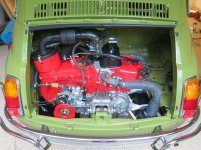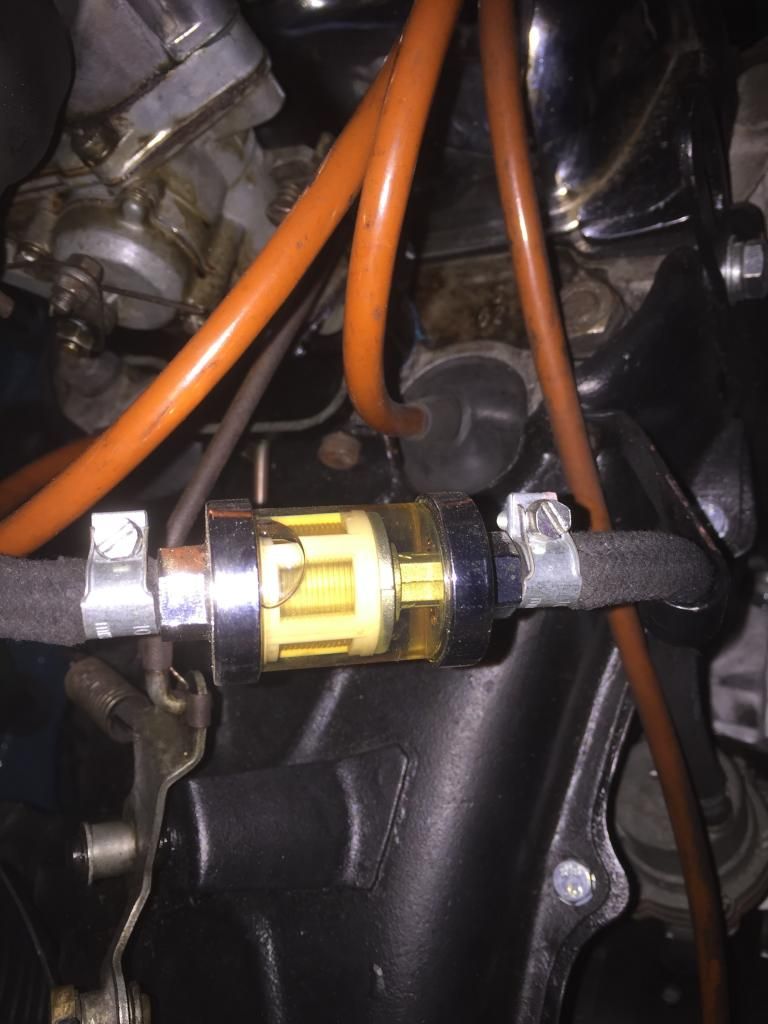This little car is really trying to kill me. I have a new, complete, 650cc Sport engine from Mr Fiat. Installed it two weeks ago and after a little tinkering and getting the 650 to fit my old 500, it started and ran fine. Took it for a 15 mile trip to dinner, then 15 miles home, and it ran fine. Next day, took it 5 miles to a friends house, turned it off, started it 15 minutes later and it hasn't run right since. Down on power (WAY down) and won't rev up without missing, bucking and mild backfiring. We drove below 1k RPM bucking and puttering the whole way home.
A timing light on #1 showed it was missing, so I chased that for a while. Points set, timing checked, even tried a new coil and a 2nd distributor and wires from the old 500 engine. Now the ignition is perfect, but the problem remains.
Checked the head bolt torque and did a valve adjustment just in case. No change.
So, fuel. I've got a clear fuel filter that looks empty all of the time. I don't see how the car runs without this being full of fuel, but it does.
When I installed the new engine, I ran the 28IMB's return line to the main fuel line entering the engine bay, before the filter and the pump. Thought this might cause issues, so pinched that off. No change.
To eliminate the fuel line in the car, the fuel tank and the pickup, I ran a hose from a gas can right in to the fuel pump. No difference. Rev it up and it doesn't like it.
Sprayed carb cleaner at the base of the carb and idle changed. Tightened the carb mounting screws and it no longer reacts to the carb cleaner sprayed here. No change in my problem, though.
The Haynes manual says my symptoms point to a clogged main jet. Chris posted lots of info on the 28IMB, so I looked up how to get the main jet out. Chris shows access to the main jet from outside the carb, but apparently this doesn't apply to my new Polish Weber! Before I pull it apart, I thought I would try the old 26IMB. It starts and idles fine, but as soon as I crack the throttle open it dies. Easily restarts, but won't rev above idle at all.
I'm suspicious of the fuel pump but need your feedback. Should the fuel filter have a mist, a little or a lot of fuel in it? I pulled the filter out just in case, but no change. The engine has a new fuel pump. New everything! In an attempt to raise fuel pressure, I removed one gasket from the pump's mount. No difference. There is a screw on top of the fuel pump - what is this for? I haven't tried it yet.
The new engine originally ran FINE for three short trips. What changed? I can see dirt clogging the main jet of the 28IMB, so I'll chase that next. What else can suddenly do this? What have I missed?
A timing light on #1 showed it was missing, so I chased that for a while. Points set, timing checked, even tried a new coil and a 2nd distributor and wires from the old 500 engine. Now the ignition is perfect, but the problem remains.
Checked the head bolt torque and did a valve adjustment just in case. No change.
So, fuel. I've got a clear fuel filter that looks empty all of the time. I don't see how the car runs without this being full of fuel, but it does.
When I installed the new engine, I ran the 28IMB's return line to the main fuel line entering the engine bay, before the filter and the pump. Thought this might cause issues, so pinched that off. No change.
To eliminate the fuel line in the car, the fuel tank and the pickup, I ran a hose from a gas can right in to the fuel pump. No difference. Rev it up and it doesn't like it.
Sprayed carb cleaner at the base of the carb and idle changed. Tightened the carb mounting screws and it no longer reacts to the carb cleaner sprayed here. No change in my problem, though.
The Haynes manual says my symptoms point to a clogged main jet. Chris posted lots of info on the 28IMB, so I looked up how to get the main jet out. Chris shows access to the main jet from outside the carb, but apparently this doesn't apply to my new Polish Weber! Before I pull it apart, I thought I would try the old 26IMB. It starts and idles fine, but as soon as I crack the throttle open it dies. Easily restarts, but won't rev above idle at all.
I'm suspicious of the fuel pump but need your feedback. Should the fuel filter have a mist, a little or a lot of fuel in it? I pulled the filter out just in case, but no change. The engine has a new fuel pump. New everything! In an attempt to raise fuel pressure, I removed one gasket from the pump's mount. No difference. There is a screw on top of the fuel pump - what is this for? I haven't tried it yet.
The new engine originally ran FINE for three short trips. What changed? I can see dirt clogging the main jet of the 28IMB, so I'll chase that next. What else can suddenly do this? What have I missed?



